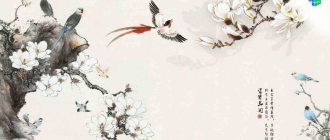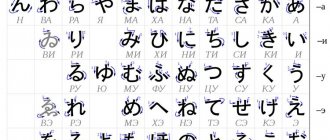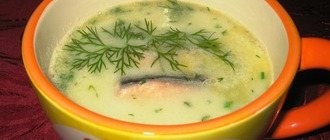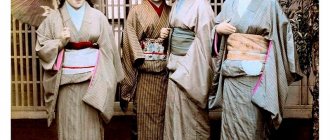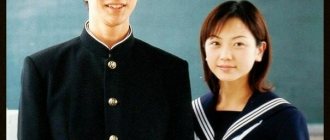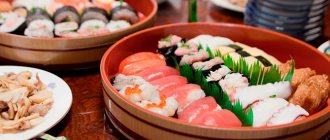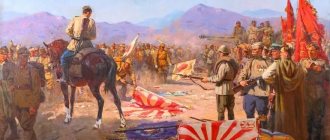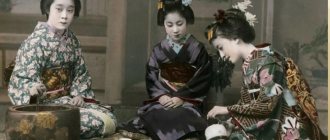Jisei: The Dying Poems of the Samurai
Poems, tanka and haiku written by Japanese samurai before their death, as an epitaph for themselves
Here are presented “jisei”, “farewell to the world” - a special genre of Japanese poetry. They were composed by samurai, robbers and poets in the face of imminent death. In some cases they were written before a battle, some before an execution, or during a terminal illness.
Ariwara no Narihira (825–880), poet, grandson of Emperors Kammu and Heizei, one of the six greatest poets of antiquity. He became famous as the author and possible hero of “Ise-monogatari,” an early 10th-century story about the love affairs of a metropolitan gentleman.
I knew: this path - Sooner or later - everyone is destined to walk. But now it’s my turn, No, I didn’t think about that...
Taira no Tadanori (1144–1184), younger brother of Taira no Kiyomori, who became the head of the clan after the death of his elder brother. Killed at the Battle of Ichinotani, the verse was found in his helmet after his death.
On the way to spend the night I will stop under a tree and fall asleep in its shade. Let the cherry blossoms give me shelter this night.
Saigyō (1118–1190), Buddhist monk, great poet who reformed the tanka genre. He died at the Hirokawa Temple in Kawachi Province.
To die in the spring, Lying so that the cherry blossoms fall on me, And so that the full moon shines on me from above.
Ouchi Yoshitaka (1507–1551), prince of Suo Province, lost in an intra-clan struggle to Sue Harukata and committed suicide.
Both the winner and the vanquished In the playground of this world - No more than a drop of dew, No longer than a flash of lightning.
Ashikaga Yoshiteru (1536–1565), 13th shogun of the Ashikaga dynasty. He died in a battle with the vassals of the Miyoshi clan, who sought his removal in order to place the puppet shogun Ashikaga Yoshihide on the throne.
First summer rain. Are these tears? Dew? Oh, cuckoo! My name is on wings, take it beyond the clouds!
Bessho Nagaharu (1558–1580), warlord during the Warring States era, sided with the Mori clan. Besieged at Miki Castle by the troops of Toyotomi Hideyoshi and forced to surrender the castle, he committed suicide in exchange for preserving the lives of the garrison.
Now, regretting my lot, I still wouldn’t exchange my share with any other person.
Shimizu Muneharu (1537–1582), daimyo during the Warring States era. Ruler of Bitchu Province, fought against Toyotomi Hideyoshi. He committed suicide in defeat.
Now crossing the swell of this world, I ask: the name of the warrior Here, under the pine tree, Leave in the moss...
Toyotomi Hideyoshi (1537–1598), a vassal of Oda Nobunaga, a descendant of simple peasants who rose to the rank of military leader. After his death, Nobunaga completed the unification of Japan.
The dew falls and disappears in the morning. Am I not like that? Whatever you say, life is a dream, just a dream.
Oishi Yoshio (1659–1703), leader and inspirer of the 47 samurai of Ako, famous for their revenge on Asano Naganori.
How good it is, having cleansed your thoughts, throwing your body aside like a rag, admiring the clear moon floating in the cloudless sky.
Oishi Yoshikane (1688–1703), eldest son of Oishi Yoshio, one of the 47 ronin. The youngest of the Avengers.
At the hour of parting, Throwing away fear, I think about the hour of meeting, And I leave the word in memory of myself.
Shimagi Akahiko (1876–1926), Japanese poet, editor of the literary magazine Araragi. He died of a stomach ulcer.
Where did the dog go, that he was so used to coming to me? Evening has already come. Drowsiness makes my eyelids heavy, I keep thinking about him...
Onishi Takijiro (1891–1945), admiral of the Japanese Navy. One of the main initiators of the creation of "simpun" units, better known as kamikaze. After the surrender, he committed suicide by committing seppuku. The agony lasted several hours, during which he managed to show his dying poems to the adjutant. “Not bad for an old man?” - he asked.
Clean and fresh, After a furious storm The moon shines. Let my dream last a hundred times for ten thousand years.
10499
Samurai and... poetry
How is this, friends? Man looking at cherry blossoms
And on his belt is a long sword! Mukai Kyorai (1651 – 1704). Translation by V. Markova
From childhood, samurai were instilled not only with loyalty to military duty and taught all the intricacies of military craft, but they were also taught relaxation, because a person cannot do only what to do, think about death or kill his own kind! No, they were also brought up with the ability to see beauty, appreciate it, admire the beauties of nature and works of art, poetry and music. Moreover, the love of art was just as important for the samurai as military skill, especially if the samurai warrior wanted to become a good ruler in peacetime. From his house, as a rule, there was a beautiful view of nature, an unusual garden, for example, and if there was none, then the gardener, using special techniques, should have created the illusion of a distant landscape in it. To do this, small trees and large stones were placed in a special order, combined with a pond or stream with a small waterfall. In his free time from military affairs, the samurai could enjoy music, for example, listening to the biwa (lute), and also the songs and poems of some wandering musician who came to his estate. At the same time, he himself simply sat on the tatami and sipped tea, enjoying the peace and realizing that there was no past or future, but only one single “now.” It was impossible not to know the poetry of famous poets, if only because, when committing seppuku, the samurai was simply obliged to leave his own dying poems. And if he couldn’t do this, it means... he died ugly, and “ugly” means unworthy!
Do you think these women are playing cards? No, they are playing... poetry! And this game remains a favorite among the Japanese to this day.
It is therefore not surprising that samurai stories, like many other Japanese narratives, feature poetry. By the way, a distinctive feature of Buddhist works, as well as Chinese treatises, are also the verses that their authors inserted into their key places. Well, since Japanese authors borrowed a lot from China, it is clear that it was from them that they borrowed this old rhetorical device. Well, as a result, both the samurai warrior and poetic creativity also became practically inseparable from each other.
However, something similar was observed with the knights of Western Europe, and the knights of Rus'. Minstrel songs were held in high esteem there, and many knights composed ballads in honor of their beautiful ladies, or... dedicated their muse to Christ, especially those who went on crusades. Moreover, the difference was not even in the content (although it was also present in it), but in the size of the poetic works.
Like many other samurai, Uesuge Keshin was not only an excellent commander, but also an equally good poet. Color woodcut by Utagawa Kuniyoshi.
In the 7th century, and some researchers believe even earlier, Japanese versification was based on line lengths of 5 and 7 syllables. At first, their combination was used in an arbitrary manner, but by the 9th century, a rhythmic pattern that looked like this: 5-7-5-7-7 became the rule. This is how the thangka, or “short song,” came into being and became very popular. But as soon as tanka became the standard of versification, people appeared who proposed to “break” it into two uneven hemistiches - 5-7-5 and 7-7. Two poets took part in the versification, each of whom composed his own hemistich, after which they were combined, and their order could change: first 7-7, and then 5-7-5. This form is called renga - or “connected verse”. Then these two hemistiches began to be linked with each other up to fifty times, and thus entire poems appeared, consisting of a hundred parts, and up to a dozen poets participated in their writing.
The easiest way to understand renga (that is, how to combine these hemistiches) is to imagine that you and your friend are playing... riddles, but only in verse; you say the first line, he says the second. That is, in essence, it is a kind of “word game”. Thus, in “Heike Monogatari” there is a story about Minamoto no Yorimasa (1104 – 1180) - a samurai who killed with a bow a certain fantastic beast, which on a black cloud descended to the very roof of the emperor’s palace and gave him nightmares. The Emperor, naturally, thanked Yorimasa and gave him a sword. This sword, in order to hand it over to Yorimasa, was taken by the Minister of the Left (and there was, of course, also a right one!) Fujiwara no Yorinaga (1120 - 1156) and headed up the stairs towards him. And then suddenly the cuckoo crowed, thus heralding the beginning of summer. The minister, without hesitation, commented on this in verse (5-7-5): “The cuckoo cries above the clouds.” But Yorimasa didn’t make a mistake either. He knelt down and answered him accordingly (7-7): “And the crescent moon disappears.”
It is interesting that if this poem had been written by one poet, it would have been called tanka, and the tanka would have turned out simply wonderful. But the same poem, but composed by two different people, turned into a renga, and the play on words, of course, decorates it. Yorinaga was generally a master of renga and a very observant person, as evidenced by many of his poems.
The fun of making up long renga at feasts arose, which in the 14th century became a real passion for many samurai. Accordingly, the rules of versification became more and more complicated, but despite this, this game continued to be very popular, even in the era of the “Warring States”.
Although tanka poetry continued to be popular, the ability to convey traditions in it was also very important. So, in 1183, fleeing the army of the Minamoto wedge, the Taira clan fled from the capital to the west, taking with them the young emperor Antoku (1178 - 1185). At the same time, one of the commanders of the Taira army, Tadanori (1144 - 1184), returned only to say goodbye to his mentor, Fujiwara no Shunzeyu (1114 - 1204), who taught him poetry. “Heike Monogatari” says that upon entering Shunjia, he said: “For many years, you, teacher, have kindly led me along the path of poetry, and I have always considered it the most important. However, for the last few years there has been unrest in Kyoto, the country has been torn apart, and now trouble has touched our home. Therefore, without in any way neglecting my studies, I did not have the opportunity to come to you all the time. His Majesty left the capital. Our clan is dying. I heard that a poetry collection was being prepared, and I thought that if you would indulge me and include one of my poems in it, it would be the greatest honor of my life. But soon the world turned into chaos, and when I learned that work had been suspended, I was very upset. When the country calms down, you are destined to continue drawing up the imperial assembly. If in the scroll that I brought you you find something worthy and deign to include one poem in the collection, I will rejoice in my grave and protect you in the distant future.”
More than 100 poems were written on his scroll. He pulled it out from behind the breastplate of his armor and handed it to Shunzei. And he actually included in the anthology “Senzai shu”, on which he worked at the order of the emperor, one single poem by Tadanori, without indicating his name, because he, even though he had already died, was considered an enemy of the emperor. So that's what it was about? About the life and exploits of a samurai warrior? About the confusion of feelings at the sight of how fate itself suddenly turned away from his clan? About the suffering of people in a bloody clan war? Not at all. Here it is:
Shiga, the capital of the murmuring waves, is deserted, but the cherries in the mountains remain the same*.
This poem itself was just a response to the events of 667, when Emperor Tenji (626 - 671) moved the capital from the city of Shiga to the city of Otsu, that’s all! Translated from the Japanese language of allegory, Shiga is “deeds of bygone days,” but despite its brevity, it contains a deep philosophical meaning: the capital, created by the labor of people, is abandoned, but natural beauty is eternal. That is, in Shunzeyu’s opinion, this was Tadanori’s best poem, and all the others were also written within the framework of plots and language that were considered decent for court poetry. That is, Shunzei’s demands on imagery, style and content were exceptionally great!
In this print (Tsukioka Yoshitoshi, 1886), a samurai in full armor plays the biwa.
Another similar poem was written by Hosokawa Fujitaka. And it is very topical, although old:
In a world that has remained unchanged since ancient times, word-leaves retain seeds in the human heart**.
And he wrote this in 1600, when his castle was surrounded by superior enemy forces. He sent this poem to the imperial court, and wrote everything he knew about the “secret meaning” of the famous imperial anthology of Japanese poets, Kokinshu. It was compiled at the beginning of the 10th century and was full of all sorts of omissions and hints, the meaning of which by that time people had already begun to forget, and so Fujitaka, although he was a warrior, wrote about all these interpretations and discrepancies to the emperor, that is, he conducted a kind of complex and thorough content analysis. Emperor Goyozei (1571 - 1617), famous for his learning, was greatly saddened when he learned that such an expert in ancient texts was about to perish; Moreover, he decided to save Fujitaka, and he (although not without difficulty) succeeded. The fact is that Fujitaka at first refused to surrender, but the emperor, through his envoys, managed to convince him to give up his samurai honor.
The commandments of the secrets of life success, compiled by Tokugawa Ieyasu. From the collection of Toshogu Temple.
But this is important: the poem, although it was written under completely extraordinary circumstances, was devoid of even the slightest hint of a military theme. It is impossible to even imagine that it was written by a samurai, and even one besieged in his own castle! That is, this warrior saw in poetry something more than a means to pour out his soul in poetry, or simply tell the whole world about his misadventures! Although, of course, as in any society, there were much more simply dashing grunts, drunkards, and not very noble and worthy people among the samurai than talented poets, art connoisseurs and true “masters of the sword.”
Many Japanese commanders were also good poets. For example, Uesuge Kenshin, after capturing Noto Castle, decided to give his warriors a little rest. He ordered sake to be distributed to them, gathered the commanders, after which, in the midst of the feast, he composed the following poem:
It's cold in the camp, the autumn air is fresh. Geese fly by in a row, the midnight moon shines. Echigo Mountains, now Noto has been taken. It’s all the same: when people return home, they remember the trip***.
Then he selected warriors with good hearing and ordered them to sing these verses! Moreover, one can even say that not a single significant event in the history of Japanese samurai could have happened without poetry. For example, the killer of the unifier of Japan, Oda Nabunaga, did his job after a poetry competition, and discovered his secret intention precisely in fears, although at that moment no one understood their secret meaning. But after the magnificent funeral arranged by Oda Nobunaga after his death, a renga competition was again organized in his honor, in which each of the participants wrote the following line:
The black-stained evening covers my sleeve with dew. Fujitaka Both the moon and the autumn wind mourn over the field. Ryogo-in When I return, crickets are crying bitterly in the shadows. Shoho****
Well, then the Japanese decided: why use a lot of words if “brevity is the sister of talent”? So they reduced the renga form to just the “opening stanza,” and that’s how haiku (or haiku) poetry was born. In the Edo era (17th century), haiku was already an independent poetic form, and the term “haiku” itself was proposed to be used by the poet and literary critic Masaoka Shiki at the end of the 19th century so that these two forms could be distinguished. True, this time was already at the end of samuraiism as a social institution, but the samurai themselves did not disappear anywhere and many of them involuntarily became poets, trying to feed themselves at least by selling their own poems.
Great battle. Utagawa Yoshikazu. Triptych 1855. Notice how the central character fights with a truly huge kanabo club. It is clear that such warriors could be glorified both in painting and in poetry.
But was Japanese poetry really that different from European poetry? And if samurai wrote poetry in preparation for suicide, or even just for fun, then didn’t the knights of Western Europe do the same thing? After all, there were also poets and singers there, and it is known that some of them were so masterful in the art of versification that they traveled around the castles of Europe and earned their living by reading their poems while visiting one or another count or baron. And in the end they received shelter, hard cash, and even the gratitude of a noble lady, the owner of the castle! All this is true, however, when comparing their poetry, you inevitably notice that, although love in both Europe and Japan was sung in approximately the same way (although the Japanese were not as verbose as the Europeans!), the samurai especially wrote about their military deeds in poetry did not spread. Whereas in the West, poems in which chivalry was sung were held in high esteem. And here are some poems, for example, that the poet Bertrand de Born wrote about knightly battles:
The ardor of battle is dearer to me than Wine and all earthly fruits. Here the cry is heard: “Forward! Be brave!” And neighing, and the sound of horseshoes. Here, bleeding, they call their own: “Help! To us!" The fighter and the leader fly into the gaps of the pits, grabbing the grass, With a hiss of blood on the brands, Runs like streams... Bertrand de Born. Translation by V. Dynnik
Poems of religious content to the glory of Buddha, much less to the glory of Christ, were not typical for samurai. Or, for example, those that depicted the experiences of a crusader knight preparing to go to Palestine to conquer the Holy Sepulcher. So none of the Japanese samurai poets praised Buddha in a lofty style and said that “without him the white light is not dear to him.” The samurai simply did not allow such “mental striptease”! But their European sword brothers - as many as you like!
Death caused me terrible harm, taking Christ away. Without the Lord the light is not bright and life is empty. I have lost my joy. There is vanity all around. My dream would only come true in heaven. And I seek paradise, leaving my homeland. I'm setting off on the road. I hasten to help Christ.
Hartmann von Aue. Translation by V. Mikushevich —————————————————————————————————— Oh, knights, rise, the hour of action has come! You have shields, steel helmets and armor. Your dedicated sword is ready to fight for your faith. Give me strength, oh God, for new glorious battles. I, a beggar, will take rich spoils there. I don’t need gold and I don’t need land, But maybe I, a singer, a mentor, a warrior, will be forever awarded Heavenly bliss.
Walter von der Vogelweide. Translation by V. Levik
This color woodcut by Migata Toshihide depicts the famous military leader, Kato Kiyomasa, in the tranquil surroundings of his home.
Now look at examples of poetry from the Edo era, the era of peace (although they are not much different from those that were written, for example, during the Sengoku period!), and, without exaggeration, the heyday of Japanese culture. For example, these are the poems of Matsuo Basho (1644 - 1694), a recognized master of renga and creator of the genre and aesthetics of haiku poetry, who, by the way, was born into a samurai family.
A raven sits alone on a bare branch. Autumn evening. ——————————————— How the banana moans from the wind, How the drops fall into the tub, I hear all night long.
Women drink tea and play poetry. Artist Mitsuno Toshikata (1866 – 1908).
Hattori Ransetsu (1654 - 1707) - a poet of the Basho school, whom he spoke highly of, was also born into the family of a very impoverished samurai, at the end of his life he became a monk, but wrote excellent poetry in the haiku genre.
Here a leaf has fallen, Here another leaf is flying in an icy whirlwind*.
What else can I add here? Nothing!
**** Hiroaki Sato. Samurai: History and Legends. Translation by Kotenko R.V. – St. Petersburg: Eurasia, 2003.
Japanese Classical Poetry: SONGS OF MORTH
Heian period IX-XII century
“KOKINWAKASHU” “COLLECTION OF OLD AND NEW SONGS OF JAPAN”
Scroll XVI SONGS OF SORRY
856 Who will see the flowers that bloomed here in the spring? - Your garden is now dead, and under the white clouds the grass is crowding into the clearing... (UNKNOWN AUTHOR)
859 In the autumn, suffering from illness and not finding consolation in anything, Chisato sent this song to a friend. Our mortal life is fragile and short-lived, like an autumn leaf that, clinging to a maple branch, trembles under a gust of wind... (OE-NO CHISato)
861 Weak, on my bed of illness I composed this song. I too had heard about the path without return that awaits us ahead, but I did not expect that today or tomorrow I would have to go that way... (ARIWARA NO NARIHIRA)
Scrolls XVII, XVIII MISCELLANEOUS SONGS 875 Composed of the Incident when some ladies, looking at Kengei, laughed. Even if my appearance is unprepossessing, but even a rotten tree that is hidden in the mountains will bloom in the spring, as before, if the heart tells it... (KENGEI)
879 Untitled The sight of the autumn moon, alas, does not bring joy! Does it decrease, does night come from night - meanwhile we grow old under the moon... (ARIWARA NO NARIHIRA)
909 Untitled Who will I be friends with now in a changed world? Even the pine trees do not greet me, as before, in Takasago with a welcoming noise... (FUJIWARA NO OKIKAZE)
919 On the day when the Emperor-in-abdication went to the Western River, Tsurayuki was ordered to compose a song on the theme “Cranes on the Shoals.” It’s as if the waves of the river, drawn by the whim of the wind, run onto the shore and are in no hurry to return - the cranes in the reeds turn white... ( KI-NO TSURAYUKI)
931 Song about flowers painted on a screen Many springs have passed since those flowers first bloomed on the branches - Oh, if only the time of blooming would last forever in our world!.. (KI-NO TSURAYUKI)
939 Those words, where the sorrows and joys of the world shine through, tied me to life in this mortal vale, from which I wanted to leave... (ONO-NO KOMACHI)
943 Untitled Do I exist or is all this just an illusion? No matter what you judge, I’ll say about life: “What a beauty!” And I’ll also say: “What a torment!” (UNKNOWN AUTHOR)
951 Untitled The older I get, the more worries and sorrows I have - apparently, the time has come for the Yoshino Mountains to leave the world along the flinty path... (UNKNOWN AUTHOR)
983 So I live in a skete east of the capital among tame deer. It is no coincidence that the place is called Ujiyama, the Mountain of Sorrows... (KISEN)
989 I am just dust in the wind that rushes, knowing no rest, no one knows where - and unknown to me, a wanderer, where I will find refuge in the world... (UNKNOWN AUTHOR)
INDEX OF AUTHORS' NAMES "KOKINWAKASHU"
Ariwara no Motokata (mentioned 900) - son of Ariwara no Muneyana, governor of the province of Chikuzen. The adopted son of Chancellor-Regent Fujiwara no Kunitsune, his sister's husband.
Ariwara no Narihira (825-880) - son of Prince Abe, grandson of Emperor Heizei. One of the “six wizards of poetry.” He is one of the main characters of the famous literary monument of the 10th century. - “Ise monogatari.”
Ise is the daughter of Fujiwara no Tsugukage, governor of Ise from 885 to 890. She served at the court of the empress.
Ki no Akimine (mentioned 890) - a nobleman of the sixth rank.
Ki no Tomonori (d. 906 (?)) - one of the compilers of Kokinwakashu. He occupied various court positions.
Ki no Tsurayuki (d. 945 (?)) is one of the compilers of Kokinwakashu and the author of the Preface in Japanese.
Kiyohara no Fukayabu (mention 910) - in 908 he was appointed Head of the Department of Crafts, and in 923 - Head of the Department of Palace Warehouses and Storehouses.
Kisaeng is a priest. One of the “six wizards of poetry.”
Kengei (mentioned 875-885) - priest.
Mibu no Tadamine (mentioned 920) is one of the compilers of Kokinwakashu. Noble of the sixth rank. He held various positions at court.
Muneoka no Oyori - there is no information about him.
Ono no Komachi (9th century) - one of the “six magicians of poetry.”
Ono no Takamura (802–852) became famous as a writer of poetry in Chinese.
Oshikochi no Mitsune (mentioned 900-920) - one of the compilers of Kokinwakashu.
Oe no Chisato (died at the beginning of the 10th century) - belonged to an old family of scientists and writers.
Sakanoe no Korenori (mentioned 905-925).
Sosei (d. c. 909) - priest of the Urin-in temple. In 896 he was appointed master of fine arts.
Sugawara no Michizane (845-903) - author of several poetry collections, as well as historical works.
Taira no Sadafun (871(?)-931).
Fujiwara no Yoruka (mentioned 875) is the daughter of the court lady Kyoshin, who became a monk. She served at court.
Fujiwara no Okikaze (mentioned 900) - son of Fujiwara no Mitinari. Famous musician.
Fujiwara no Sekio (815-853) - did not serve at court due to illness. He was famous for his skillful playing of the zither-koto, as well as his talent as a calligrapher.
Fujiwara no Tadayuki (d. 906) - held various positions at court.
Fujiwara no Toshiyuki (d. 901 (907?)) - held various positions at court.
Funya no Yasuoshide (mentioned 860) - one of the “six magicians of poetry.”
Harumichi no Tsuraki (d. 920) - was appointed governor of Iki in 920, but died before taking office.
Henjo (816–890) was the secular name of Yoshimune no Munesada. One of the “six wizards of poetry.”
Yusen (836-900) - Buddhist priest. Have you read Japanese classical literature: anthology: from the text collection: khokku.ru

